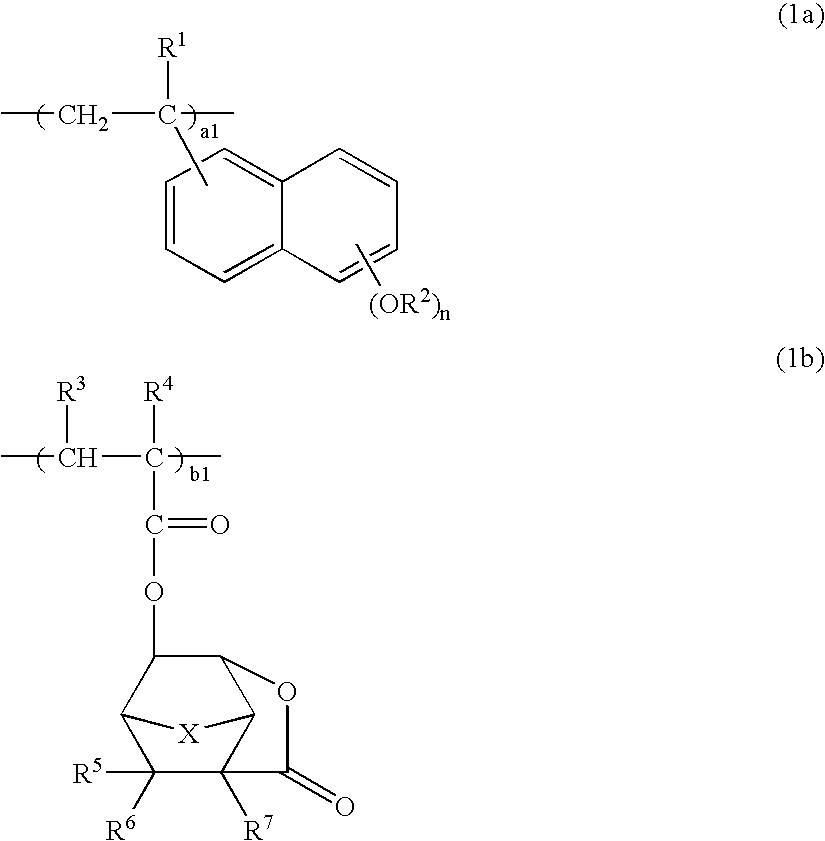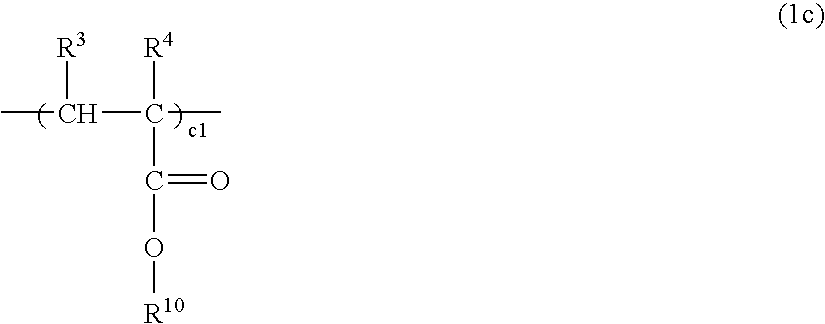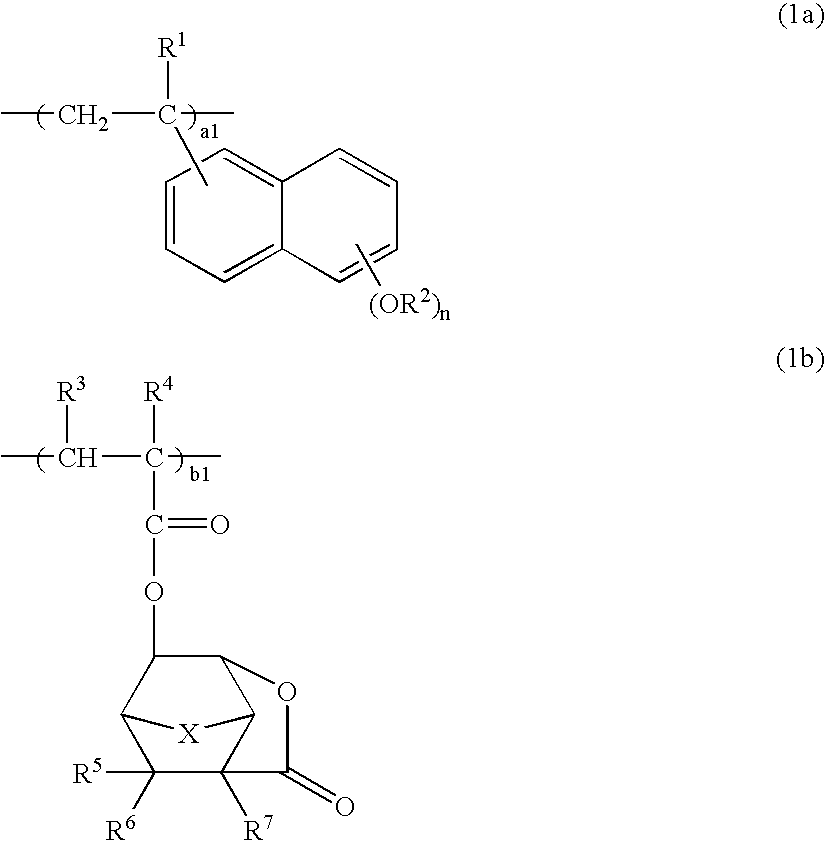Polymers, positive resist compositions and patterning process
a technology of compositions and polymers, applied in the field of polymers, positive resist compositions and patterning process, can solve the problems of difficult use as the base resin of resists, high acidity of carboxylic acids, and high difficulty in reducing the number of polymers, so as to minimize the roughness of line edges, high sensitivity, and high resolution
- Summary
- Abstract
- Description
- Claims
- Application Information
AI Technical Summary
Benefits of technology
Problems solved by technology
Method used
Image
Examples
synthesis example 1
[0181]A 100-mL flask was charged with 8.1 g of 2-ethyl-2-adamantane methacrylate, 6.3 g of 3-hydroxy-1-adamantyl methacrylate, 6.7 g of 3-oxo-2,7-dioxatricyclo[4.2.1.04,8]-nonan-9-yl methacrylate, 2.6 g of 2-vinyl-6-ethoxyethoxy-naphthalene, and 20 g of tetrahydrofuran as a solvent. The reactor was cooled to −70° C. in a nitrogen atmosphere, followed by three cycles of vacuum evacuation and nitrogen flow. The reactor was warmed up to room temperature, charged with 0.2 g of AIBN as a polymerization initiator, heated at 60° C., and held for 15 hours for reaction. The reaction solution was poured into 500 mL of isopropyl alcohol for precipitation. The white solids were collected by filtration, dissolved again in 200 mL of methyl ethyl ketone, and combined with 5 g of oxalic acid and 3 g of water. Deprotection reaction of ethoxyethoxy groups occurred at 60° C. for 5 hours, followed by three cycles of separatory washing with 500 mL of water. The reaction solution was concentrated and dis...
synthesis example 2
[0188]A 100-mL flask was charged with 8.1 g of 2-ethyl-2-adamantane methacrylate, 6.3 g of 3-hydroxy-1-adamantyl methacrylate, 8.4 g of 3-oxo-5-methoxycarbonyl-2-oxatricyclo[4.2.1.04,8]-9-nonyl methacrylate, 2.6 g of 2-vinyl-6-ethoxyethoxynaphthalene, and 20 g of tetrahydrofuran as a solvent. The reactor was cooled to −70° C. in a nitrogen atmosphere, followed by three cycles of vacuum evacuation and nitrogen flow. The reactor was warmed up to room temperature, charged with 0.2 g of AIBN as a polymerization initiator, heated at 60° C., and held for 15 hours for reaction. The reaction solution was poured into 500 mL of isopropyl alcohol for precipitation. The white solids were collected by filtration, dissolved again in 200 mL of methyl ethyl ketone, and combined with 5 g of oxalic acid and 3 g of water. Deprotection reaction of ethoxyethoxy groups occurred at 60° C. for 5 hours, followed by three cycles of separatory washing with 500 mL of water. The reaction solution was concentrat...
synthesis example 3
[0195]A 100-mL flask was charged with 6.9 g of 3-ethyl-3-exotetracyclo[4.4.0.12,5.17,10]dodecanyl methacrylate, 6.3 g of 3-hydroxy-1-adamantyl methacrylate, 7.8 g of 3-oxo-2,7-dioxatricyclo[4.2.1.04,8]nonan-9-yl methacrylate, 2.6 g of 2-vinyl-6-ethoxyethoxynaphthalene, and 20 g of tetrahydrofuran as a solvent. The reactor was cooled to −70° C. in a nitrogen atmosphere, followed by three cycles of vacuum evacuation and nitrogen flow. The reactor was warmed up to room temperature, charged with 0.2 g of AIBN as a polymerization initiator, heated at 60° C., and held for 15 hours for reaction. The reaction solution was poured into 500 mL of isopropyl alcohol for precipitation. The white solids were collected by filtration, dissolved again in 200 mL of methyl ethyl ketone, and combined with 5 g of oxalic acid and 3 g of water. Deprotection reaction of ethoxyethoxy groups occurred at 60° C. for 5 hours, followed by three cycles of separatory washing with 500 mL of water. The reaction solut...
PUM
| Property | Measurement | Unit |
|---|---|---|
| has a wavelength | aaaaa | aaaaa |
| wavelength | aaaaa | aaaaa |
| absorption at wavelength | aaaaa | aaaaa |
Abstract
Description
Claims
Application Information
 Login to View More
Login to View More - R&D
- Intellectual Property
- Life Sciences
- Materials
- Tech Scout
- Unparalleled Data Quality
- Higher Quality Content
- 60% Fewer Hallucinations
Browse by: Latest US Patents, China's latest patents, Technical Efficacy Thesaurus, Application Domain, Technology Topic, Popular Technical Reports.
© 2025 PatSnap. All rights reserved.Legal|Privacy policy|Modern Slavery Act Transparency Statement|Sitemap|About US| Contact US: help@patsnap.com



